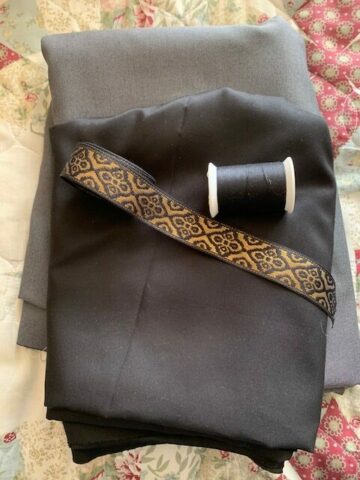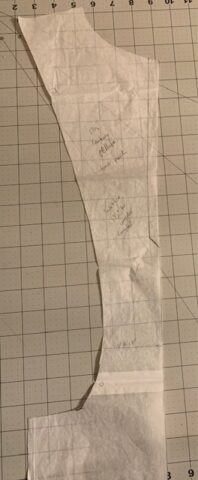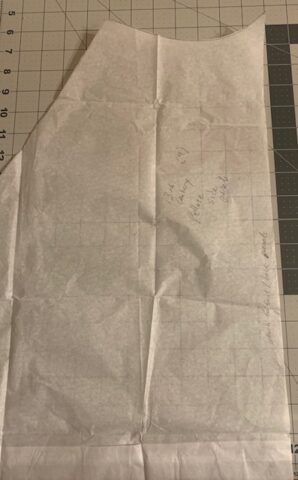II. The Pellote
A. The Materials: Fabric Choices
The cutting and construction of this surcoat layer is more or less straightforward. I was not keen on going to stores at the time, so I had gone online to purchase fabric and liner. Black liner was not a big deal. I am never again purchasing fabric online that I have not seen and touched first. I had wanted to use velvet originally, but was told that in period, velvet was so expensive to make that even royalty would only be using it for trim and for small things like purses, at least in the 13th century. The wool I got was supposedly medium weight but ended up being almost summer suiting. I ended up purchasing some cotton-linen blend on sale to use as interlining to place between the almost too-light wool and the liner. That is being washed hot and set to dry at the highest temperature, and will be pressed prior to cutting.

There is trim in this picture, but I may or may not use it. The extant gown from the mid 1240s does not have evidence of trim that could be seen, but an illustration from the Book of Games by Alfonso X shows one of his daughters at a chess board.

This book is from the mid-to-late 1280s. The pellote by this time has a much narrower front and back panel, and there a hint of gold or yellow trim, either fur or dyed wool. The camisa is also elaborately embroidered, given the name camisa magomada to differentiate it from its plainer ancestor. I am making the earlier version, but include this here to show that there has been evidence of trim on pellotes, though it is hard to tell exactly what the trim was made of. Since I don’t trust myself to use fur yet, nor have the time to purchase any now, I may use some black velvet remnant I happen to have if I have the time to cut and attach it.
B. The Pattern
Commercial costume patterns for sideless surcoats are fabric hogs. The McCall’s pattern below asked for 8-1/2 yards!

The front panel for this pattern flares out at the hips, while the extant gown shows a vertical drop of the front and back panels, and the four side panels attach there. The extant gown’s side panels don’t appear to have as much flare, either. Leonor de Castilla was quite skinny when she passed at the age of 44 (and I am guessing perhaps cancer may have had a hand in that), but this lady has early 21st century, early sexagenarian Cuban hips, and needs all the side flare she can get away with. All told, four yards were purchased each for the fabric, interlining, and lining, just to be on the safe side.




Wow, that McCalls layout is so wasteful! I think there’s more ‘scrap’ than the amount of fabric in the pattern pieces.
I think that you’ll find, with this fabric, that it will look very plain without any sort of trim or embellishment. If you have the time to add that trim along the edges of the side openings, I think you’ll definitely find it worthwhile.
The trim may look nice, but would it be accurate? If I have the time, I may add it anyway, and accuracy be damned, because this fabric was purchased online, and turned out to be too light for the wool that they would have had then. The trim they used would have been fur, contrasting wool, or small amounts of velvet, not this kind of embroidered trim, though I may use some couched metallic trim instead.
Thank you for the suggestion, though.